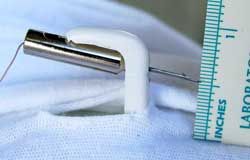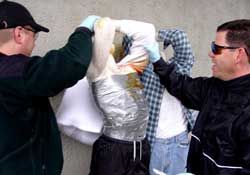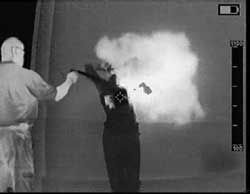By: Officer Chris Myers; Forensic Scientist Rick Wyant; Officer Tom Burns
Forensic testing of chemical agents with electronic control devices
 |
| Flammable OC when applied to the exposed Taser spark |
In the early 1990’s, portable less-lethal chemical agents became standard issue for patrol operations(1). In many cases, these agents have been successful in helping to control resistive or violent subjects without serious injury or an escalation of force. With the re-introduction of Electronic Control Devices in the late 1990’s, there is a growing concern of flammability issues when these two less-lethal devices are used simultaneously. We recently conducted forensic testing to determine which brands of OC spray would ignite in combination with Electronic Control Devices under our testing protocol.
Oleoresin Capsicum (OC-Pepper spray):
The most common chemical agent used by law enforcement is OC or pepper spray. OC sprays contain several components including a carrier, emulsifier, and propellant. They can be oil or water based and are available in different capsaicin concentrations. Every OC type does contain a certain amount of flammable/volatile material, but formulas are generally unknown as manufacturers guard their proprietary formulations.
Standards for flammability of liquids:
The US Environmental Protection Agency has set standards for rating the flammability of liquids(2):
A. Flash Point: the lowest temperature at which a liquid product containing a combustible ingredient that gives off a flammable vapor will ignite(2) . NOTE: Even though most of a liquid may be below its stated flash point, an ignition source (Taser) can create a locally heated area sufficient to result in ignition3.
B. Flame Extension Test: conducted by holding the aerosol can 6 inches from a flame and
discharging the product across the flame. Flame extension of more than 18 inches or flashback of flame to the can would dictate the labeling of the product as either being flammable or extremely flammable2.
Ignition of gases: Combustible substances in the gaseous state have extremely low mass and require the least amount of energy for ignition(3). Therefore, spray that becomes aerosolized when leaving the nozzle has the potential to be more flammable than its liquid form.
It is our opinion that the flash point and flame extension tests alone cannot accurately predict an ignition during a joint field application of OC spray and TASER or other electronic control devices.
CRT OC-TASER testing protocol:
 |
The authors created an experiment that would simulate a realistic, worst case scenario. This scenario involves a clothing disconnect, or loose probe in the suspect’s clothing with an exposed spark. The spray would be directly applied to the spark backed by a cotton t-shirt as with a clothed subject.
In late 2004, 2005 and early 2006 we conducted a series of flammability tests with TASER and OC spray. We used a TASER model M26 electronic control device and over twenty types of Oleoresin Capsicum (OC) spray. The M26 was chosen for this test over the X26 because of the greater output (1.76 joules for the M26 vs. 0.36 joules for the X26) in keeping with the “worst case,” most likely to ignite, testing. We worked under the theory that if the OC did not ignite under the worst case situation, we could comfortably carry the Taser and OC simultaneously in routine patrol operations.
The TASER probes from an XP cartridge (right) were attached to a forensic mannequin. The mannequin was covered with a conductive layer under an insulating layer. Typical cotton clothing was placed over the insulating layer. The probes were placed one foot apart on the upper torso. The top probe was placed in a fixture in the clothing one half inch from the conductive layer to simulate a clothing disconnect with exposed spark. The bottom probe penetrated making direct contact with the conductive layer.
 |
The weather conditions were recorded. Temperature and humidity affect the volatility of liquids. Testing was monitored with digital still, video, and thermal imaging. The clothing was changed after each testing event. The OC spray was applied for 2-3 seconds, 3 feet away, directly to the spark gap as the TASER was cycled for 10 seconds. After a 20 second delay, the TASER was applied for a minimum of two cycles. The OC canister was not shaken prior to testing to maintain realistic field conditions.
Forensic Testing Results:
29 types of spray were tested in four separate evolutions. One interesting finding during our testing is that we firmly dispelled common myths often heard in law enforcement circles:
Water based sprays are TASER safe”
“Cans marked ‘Non-flammable’ are TASER safe”
During our testing, eight brand types of the OC ignited the cotton clothing on the mannequin either during simultaneous application of TASER and OC or after a delay. In some cases, a direct application of the OC product onto the TASER spark did not cause immediate ignition, but the re-activation of the TASER after a delay did cause flame. The flaming after a delay is theorized to be due to a wicking effect created by the cotton clothing used for testing.
Brand Type Flammable under CRT protocol?
AERKO Punch II both “flammable” and “nonflammable” STREAM YES
AERKO FREEZE +P, OC-CS STREAM NO
Body Guard LE10* (def tech) STREAM YES
Body Guard LE10* (def tech) FOG NO
Body Guard LE10* (def tech) FOAM NO**
Counter Assault OC-10* FOG NO
CTS Mk 4 FOG NO**
CTS Mk9 FOG NO
Def Tech Pepper Foam 10% * FOAM NO
Def Tech First Defense MK-IV* STREAM NO
Def Tech First Defense X2 STREAM NO
Def Tech 5.5 Pepper mace* STREAM YES
Def Tech Pepper 10* STREAM NO
Def Tech First Defense MK-9 FOG NO
FOX spray* STREAM NO
FOX spray FOG NO
Guardian FOG YES
Guardian STREAM NO
Mace Sec. Int’l TAKEDOWN GEL NO
Pepperball CONE NO
Pepperball STREAM NO
TDS Tactical Defense Spray FOG YES
TDS Tactical Defense Spray STREAM YES
SABRE CS/Red pepper STREAM YES
SABRE RED FOAM NO
SABRE Red- H2O STREAM NO
SABRE Red- H2O FOAM NO
SABRE Red- H20 FOG NO
Zarc Cap-stun FOG YES
* tested on two separate events with different lot numbers with the same results
Some have more than one lot number tested with the same results
** Did not ignite, but raised concerns with high heat generation or hot vapor production.
 |
This series of experiments was designed to create a practical, reality based scenario similar to those faced by Law Enforcement Officers in daily operations. It is foreseeable that officers will encounter situations where Electronic Control Devices and Chemical agents are deployed simultaneously or in succession, whether by design or not.
We tried to obtain as many law enforcement grade OC products as possible for testing. Some manufacturers chose not to participate in this study preferring to rely on Flash Point and Flame Extension standards to label their products. Based on this testing protocol, we concluded that manufacturing labeling as safe and non-flammable may not be accurate under field conditions.
The testing scenario was intentionally structured to be “worst case”, one most likely to produce ignition if the agent in question was combustible. These results are not and cannot be all inclusive and applicable to every situation. It is the authors’ recommendation that agencies use these results only as a guideline for the selection of Chemical Agents in an environment with the potential Electronic Control Device deployment.”
References:
1. Armor Holdings Training Academy Manual; Defense Technology, Federal Laboratories
2. US EPA Label review Manual, Chapter 9: Physical or Chemical Hazards
40 CFR 158.190
3. National Fire Protection Association 921: Guide for Fire and Explosion Investigations 1995
About the Authors:
Rick Wyant is a forensic scientist with the Washington State Patrol in Seattle. He is a nationally recognized expert in forensic reconstruction of TASER incidents and analysis of TASER evidence. He is a distinguished member of the Association of Firearm and Toolmark Examiners, a SWGGUN board member and a reserve deputy.
Chris Myers is a Seattle Police Officer and Instructor on Less Lethal Options including the TASER, Specialty Impact Munitions, and Chemical Agents.
Tom Burns is a Seattle Police Officer and Instructor on Less Lethal Options including Specialty Impact Munitions, Chemical Agents, Crowd Control Tactics, and TASER devices.
All three authors work together to test various less lethal options under realistic conditions and instruct officers to effectively apply this technology within its limitations. For more information please visit www.CRTLessLethal.com


